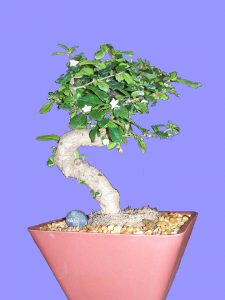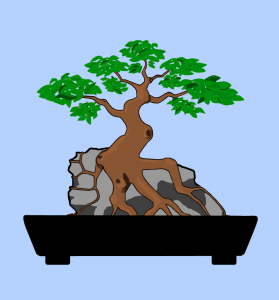My lists of favorites bonsai plants, tools, and tips
My favorite bonsai plants
Maybe if you see my favorite bonsai plants ideas, you will know what you want to use for your tree… There are many who love to look at bonsai trees, but not so many that actually want to work on them.
Maybe you don’t want to create your own bonsai tree. You can get a plant that has a natural bonsai like style to it and a very pleasing appearance like a Desert Rose. This plant even has beautiful flowers.
The other option is to get a professionally created tree. This can be one that is in process and you make it your own. Or get a tree that is completely styled to a finished state and maintain it.
My favorite bonsai plants for beginner artists
Green Mound Juniper
This is well named. You have a mound of foliage to work with here! You can style this to any design you like. Juniper do not like to be too wet. If you ever encounter problems with the condition, you can bury it in the ground and have it live more naturally. This is easier care for this plant.
Ficus (Fig)
The fig is a fast growing, flexible, and hardy plant. If it should drop all the leaves, you can just put it in a humidity tent and it will recover quickly. The humidity tent can also be used to get these plants to grow aerial roots if you would like to have them. There are so many varieties here!

My Fukien tea when I first got it… one of my favorite bonsai plants
Fukien (Fujian) Tea
This is a hardy, attractive traditional bonsai plant. It will have tiny white flowers that lead to little berries. The leaves are textured and often lobed on the tips. They are easy to find at stores that sell bonsai trees. Most often these are style to have a wonderfully curving trunk and Upright Informal (Moyogi) style. This is my favorite bonsai tree style too… If you go to my article on bonsai artist resources, I have a tutorial video for this style there.

Informal Upright (Moyogi) bonsai tree that is also root-over-rock
My favorite bonsai plants for easy care
Ficus – hardy, fast growing, easy care, easy to recover from problems. Easy to start other plants from the cuttings of your pruning work.
Fukien Tea – very hardy, attractive plant that is an easy one to find.
Pomegranate – grow well and the leaves are nice and small to work well as a bonsai tree.
Ginkgo – water loving plant that is hardy. They are an ancient, primitive plant that grow differently than other plants. They start growing very late in Spring.
Any plant you love that is local to your area – these are easy to come by and are proven to be fine for you to grow.
My favorite flowering bonsai material
Jasmine Orange – a very attractive decorative tree that has flowers that, to me, smell like sweet tarts. Lovely scent that is not overpowering and easy to have indoors.
Fukien Tea – traditional bonsai tree material that is easy to find. The flowers and berries are a nice small size that works for a bonsai tree size.
Pomegranate – these have brilliant orange trumpet shaped flowers that will turn into round fruit that is full of seeds. You can eat the fruit and the seeds.
Wisteria – these have beautiful flowers and work extremely well for Cascade or Semi-Cascade style tree. This will look great in any style.
Jasmine – besides it’s famous scent, this plant has the advantages of being a vine. It will be very flexible and fast growing. You can easily form this to the curves that you want.
Azalea – this is a popular, traditional plant for bonsai. There are varieties that are preferred for bonsai tree creation, but you can use the plant you like.
Crepe Myrtle – now that I have seen how large and incredible these look where I live now, I love these even more. The bark is smooth and beautiful. There are many flower color choices.
My ‘bucket list’ of favorite plant material
Jaboticaba – a Brazilian tree that grows flowers and then grape like fruit right from the trunk. It has a smooth peely bark in many shades of tan.
Chinese Elm – a traditional bonsai tree material that has smooth peely, light colored bark and is very attractive.
Cypress – I love the way these trees look and would like to try making a small version.
Ficus – there is so much to love with these
It is quite obvious that I am a big fan of ficus for so many reasons. For some people, the sap from these plants may be irritating. I have never personally seen this problem. You can wear gloves when you work on them if you are sensitive to them.
There is incredible variety in these plants. You can get the Elephant foot ficus with a massive root base. There is willow leaf with thick growth of willow like leaves. Green Island ficus have round or oval leaves with BB size figs. Weeping fig (Benjamina) have a wonderful growth style and are common at office plants. This makes them very easy to find. All of these are great bonsai tree material and do not look related to each other really.
My favorite tools that I most use (maybe a basic place to start for you)
The concave cutter – this is a very essential and specialized tool. There are not substitutes for this one. This tool makes a concave cut when a branch is removed. This heals to be hardly noticeable.
Knob cutter
Pruning shear
Tips and things to consider for your bonsai plant
Don’t stress about changes to your plant! This will give you freedom to enjoy bonsai work! Gorgeous trees get made by cutting a big plant back to pretty much a stump (you just have to do this in a season WHEN it will be able to grow back quickly). If you lose a branch or root… or just need one you don’t have… you can graft from a plant of the same material. You can also just go with changes. These happen in nature. Change to another bonsai tree style that fits well or try deadwood.
Outside
Some plants are at risk when outside in summer, like fruit and nut trees. These are like candy for deer, rabbits, many animals. They may need fencing to protect them.
If you have outdoor plant material, is it proper for your temperature zone? In the right temperature zone, you can plant it in the ground for Winter time. If not the correct zone for where you live, you can allow it to go through cooling weather until it goes dormant. Then store it in a cool place with a little light. If it has great light, it will come out of dormancy and start growing. They need a Winter season.
Inside
Will you need to bring your plant indoors and do you have enough room for your plants?
Bug emergency
No matter what you use to control pests on your plant, remember that a cold water shower can knock back most pests and won’t harm your plant. This can help you through problems in a pinch.
Cheaper
Instead of a getting something like a root hook, just use some of those chop sticks from your favorite carry out.
You can always bend branches downward by tying weights. If you want really sharp bends, then I recommend a branch bending tool.
Forest planting
Remember too that you have the option of a forest bonsai planting. You can have your bonsai or forest planting on a slab instead of in a pot.
Miscellaneous
I recommend NOT getting thorny or spiny plant material. This will most likely take the enjoyment out of working on your bonsai tree.
Find out if there is a bonsai club near you. This can be a source of plants, information from experienced folks, and an additional social aspect to this hobby.
If you have your eye on a boxwood, know that these grow extremely slow. You may like your tree or forest planting even more with landscaping. Proper scaled ground cover will look very nice and moss is always a good scale for your tree(s) and looks like mowed grass.
